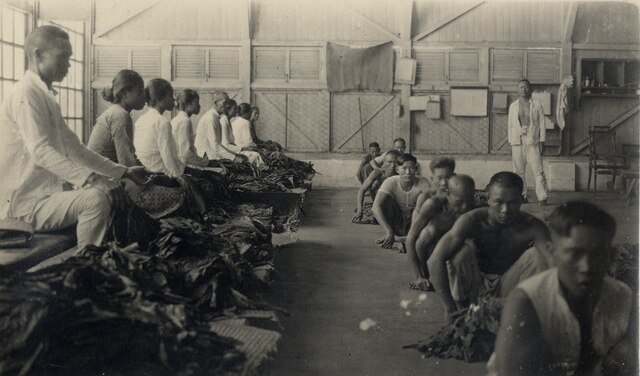Makassar International Writers Festival and its ripple effects
Caitlin Hughes
Benteng (Fort) Rotterdam is a cream-brick, red-roofed fortress complex on the historic, harbourside edge of Makassar, South Sulawesi. The seventeenth-century Dutch colonial fort does not look out of place in a part of Makassar where Chinese, Dutch, and local South Sulawesi architecture stands alongside glassy, high-rise hotels. Today the Fort is Makassar’s most famous landmark, an enduring symbol of tempo doeloe (the olden times).
When I first visited Fort Rotterdam last October it was a searing hot day at the end of the dry season and the place was eerily quiet. When I returned for the opening night of the 2024 Makassar International Writers Festival (MIWF) in late May this year, the ambience was very different. It was a clear, cool night. Crowds of people milled around the site. Someone told me that opening night is always ‘like a giant reunion’ for the local arts community and the public. There were rows of food stalls and coloured signs and banners and the main stage was decorated with bright cartoons.
Since it began in 2011, MIWF has witnessed a remarkable growth. The festival was established by the late Dr Lily Yulianti Farid, a writer and academic, through Rumata’ Artspace – a multidisciplinary ‘artspace,’ which she co-founded with prominent film director Riri Riza at the Riza family’s old home in Gunung Sari Baru, Makassar. Although some outside observers perceive MIWF to be a ‘spinoff’ event from Bali’s famous Ubud Writers and Readers Festival (established 2006), the reality is very different.
MIWF emerged from – and was shaped by – the specific needs and ambitions of South Sulawesi’s arts community. This is a landscape that already has strong literary and performance activity and identity in both traditional and contemporary contexts. MIWF has always emphasised grassroots community perspectives; in doing so, it fosters an all-encompassing inclusivity that diverges from the more exclusive, elite nature of writers’ festivals elsewhere in Indonesia. In 2020, the prestigious London Book Fair awarded MIWF an International Excellence Award, in the Literary Festival category, for its ‘radically inclusive’ programming.
MIWF 2024 was the second festival without its founder, Lily, who passed away in early 2023. But her legacy and vision is still felt in creative energies palpable and present. In 2023, there were approximately sixty panels held at MIWF, a number that had been steady for some years. In 2024, under the leadership of festival director M. Aan Mansyur, and co-director Ilda Karwayu, that number climbed to 150 programs and activities, with approximately 260 volunteers. Running simultaneously with MIWF 2024 was the annual SEAScreen Academy, a ‘story camp’ for Southeast Asian filmmakers established by Riri Riza in 2012, also organised through Rumata’ Artspace. Around this environment has swirled new, creative possibilities to expand the narratives for Eastern Indonesian arts.
Generous storytelling
MIWF 2024 opening night began with a dance and musical performance by bissu, the fifth androgynous gender in Bugis society that embody both male and female attributes. Bissu are considered spiritual mediators between humans and spirits, and as such, perform roles like that of a priest. The role of bissu in South Sulawesi life and culture for centuries is celebrated, and yet the number of bissu are declining due to escalating LGBTIQ marginalisation in Indonesia. By inviting bissu to perform at the festival’s opening night MIWF made an important statement: a gesture both in celebration of South Sulawesi culture, and as a show of support amidst increasing threats to their tradition, culture, and spiritual practices.
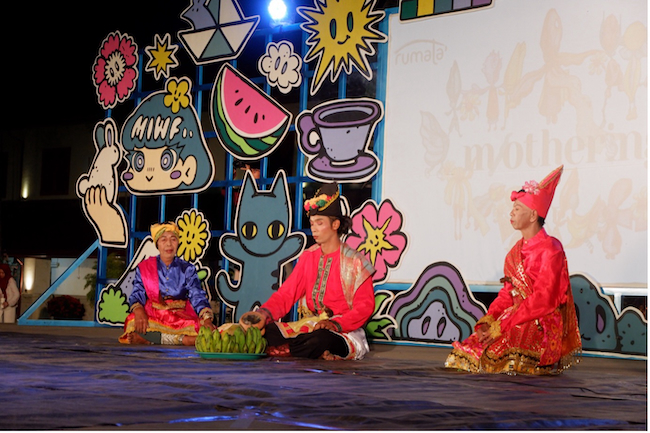
Every evening of the festival a program titled ‘Under the Poetic Stars’ featured on the main outdoor stage. Invited guests presented poetry, performance, and music. On opening night, the program kicked off with MIWF’s leadership team taking turns to read out poetry by Palestinian poets, translated into Bahasa Indonesia – a statement of transnational, translational solidarity. Similar activist principles are embedded in many other aspects of the festival; including a commitment to transparency, to zero waste and low carbon emissions, and a rule against ‘all-male panels’. On subsequent nights, this space ‘under the poetic stars’ was given to creatives both emerging and established to showcase a variety of talents.
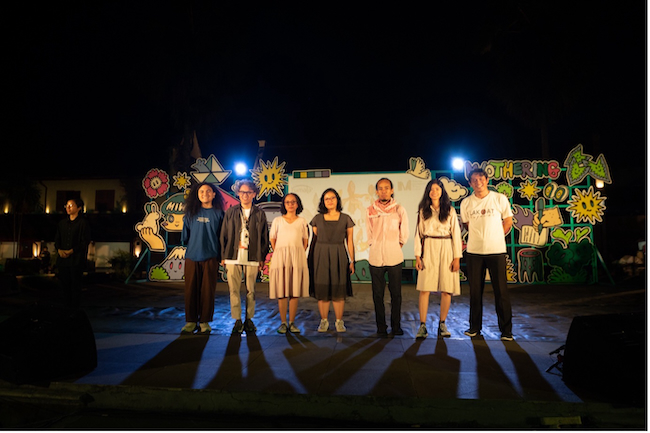
Afternoons were also filled with daily, open-mic poetry sessions. By day and by night, then, these outdoor events created a dialogue between poetics, performance, and physical open space. The emphasis on open-air performance is reminiscent of recent history – especially in the early post-New Order period – where Fort Rotterdam was a popular public space for exhibitions and events. The reformasi-era Makassar Art Forum ’99 (MAF’99, 1999) curated by Solo-based cultural networker, Halim HD, and the Journal of Moment Arts (JOMA) performing arts festival (2000-2003) also used this site. The use of outdoor space also has an embodied perspective: activating a generous, generative conversation in cycle with nature and surrounding environments. This experience and connection with the land is especially strong across South Sulawesi’s various cultures and traditions; a point raised often in conversations with artists. Sitting on the grass together, under the night sky, felt like a continuation of these various ways of storytelling.
Community spaces, space for community
The theme of MIWF 2024 was M/Othering, ‘mothering’ being the practice of caring, and ‘Othering’ of treating someone as different or 'Other' to oneself. These dual themes may seem opposite, but are they? Held together in tension, they inspired a series of critical discussions. This included on feminism and decoloniality; the role of women in filmmaking, theatre and literature; and a special performance by Luna Vidya, presenting a monologue adaptation of Dapur (Kitchen), a short story by Lily Yulianti Farid.
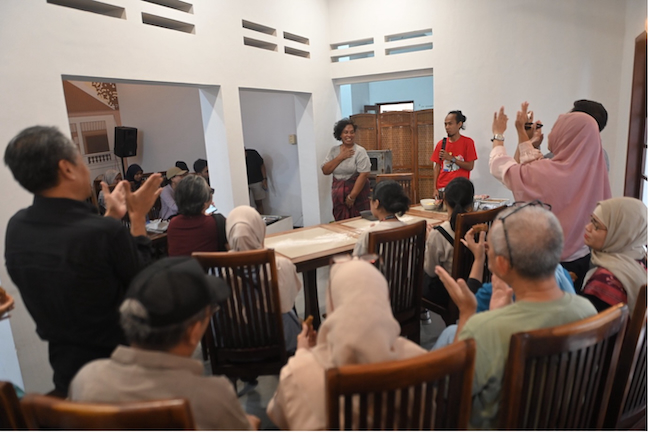
As the largest city in Eastern Indonesia, Makassar has a certain status – and, some might say, responsibility – through which to shape understandings of Eastern Indonesian arts. From its beginning, MIWF seems to have responded to this challenge by presenting a feminist space; a forum to nurture emerging perspectives, and to empower voices often omitted from Java-centric, national conversations. Through this year’s theme of M/Othering, these conversations continued.
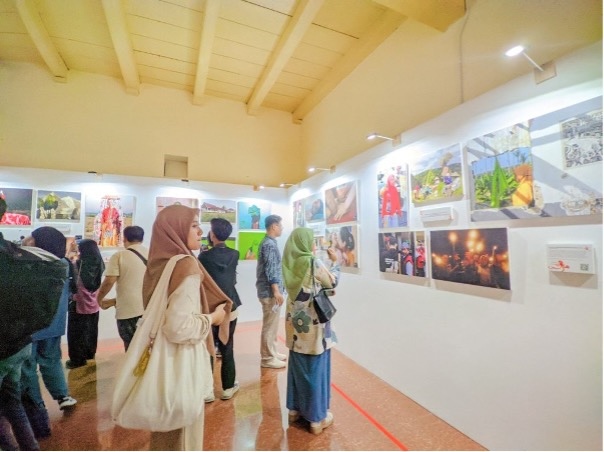
In Java, new art spaces have historically emerged from existing institutions, networks and collectives. Yet, in Makassar, various creative and interdisciplinary initiatives have largely been established in response to the lack of such spaces.
Founded in 2011, Rumata’ Artspace and MIWF are positioned in a post-Reformasi-era wave that, since 2014 in particular, has seen a number of collective spaces, music ecosystems, filmmaking communities and communal libraries established; further raising the profile for Makassar arts. What is noticeable now – particularly after the COVID years – is that the emphasis appears to be shifting across Makassar’s arts ecosystem: moving from a preoccupation with making space, to generating creative discussions through these channels.
The impact of this shift is seen at MIWF 2024, represented in the number of panels, events, and volunteers. Many volunteers were students, but participants also included members of Makassar’s various art networks. It is also demonstrated in the types of events organised, and themes for conversation. The festival was primarily interdisciplinary, looking beyond the written word to art and photography exhibitions, film screenings, theatre, and music. Fort Rotterdam’s various buildings held space for grassroots learning, doubling as cinemas, workshops, and galleries. Although these were not necessarily new activities compared to previous years, the larger scale achieved this time is notable. This interest in promoting visibility through interdisciplinarity has allowed a diverse range of art forms to be represented; in turn, feeding back into the larger Makassar arts ecosystem.
Not one narrative, but many
In researching art history, I am sometimes asked whether there is any one theme or ‘flavour’ that might capture Makassar or Eastern Indonesian art for those who have not yet visited. It is hard to find an easy answer to this question, except to point to the enthusiasm for interdisciplinarity in art-making, or a more encompassing, freed interpretation of art(s) that resists strict categorisation as seni rupa (visual art). It is difficult to answer precisely because it would pinpoint singularity in an area of Indonesia with layers of multiplicity. This plural perspective is seen in multi-ethnic, multi-cultural Makassar and South Sulawesi, and in a broader Eastern Indonesian region with incredible geographic, linguistic, and cultural diversity. There is still a tendency to see Eastern Indonesian narratives as ‘peripheral’ to Indonesian art and history. This perception is no longer sufficient, and nor is it a sustainable view. There are many shifts and vantage points from which to see Indonesian art, and Eastern Indonesia has always been important (though overlooked) in this constellation.
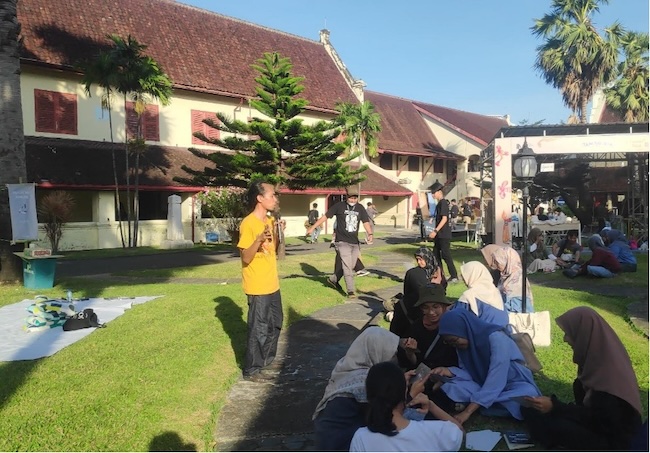
M/Othering opened multiple topics, angles, and narratives for discussion. The panels I attended discussed themes including urban issues and experiences, refugees, environmental concerns, identity, decoloniality and human rights. In this sense, it shows the importance of re-centring diversity; and shaping new, intra-national and international narratives from this perspective.
The ’International’ perspectives of MIWF and the ‘Southeast Asia’ of SEAScreen Academy situate Makassar as part of an international, regional sphere of participation. On a surface level, this included two ‘Visiting Neighbours’ forums: one for Southeast Asian panellists, and another for Australia. Bilateral exchange may have their place in these forums, but so do multilateral, postnational flows. Aside from these geographic, ‘neighbouring’ anchor-points, the scope of the activities at MIWF positioned Makassar and Eastern Indonesia within a wider set of narratives, histories, and sea of islands: looking beyond one place, out to many.
A new wave?
In recent years, there have been a few speculative conversations about an increase in visibility for contemporary art from Eastern Indonesia within Indonesia at large, as well as here in Australia. From where I sat in Melbourne, it looked like a scattered trend was emerging, albeit very slowly. This sparked my curiosity. It is why I initially decided to travel to Makassar last year, returned again this year, and no doubt will do so again into the future.
I met with an artist a few days after MIWF. It was time to nongkrong (hang out) on my last afternoon in Makassar. We were debriefing about the weekend’s events at the festival, and my friend remarked that there was a certain energy – a certain momentum – behind MIWF now, in ways that they had not seen before.
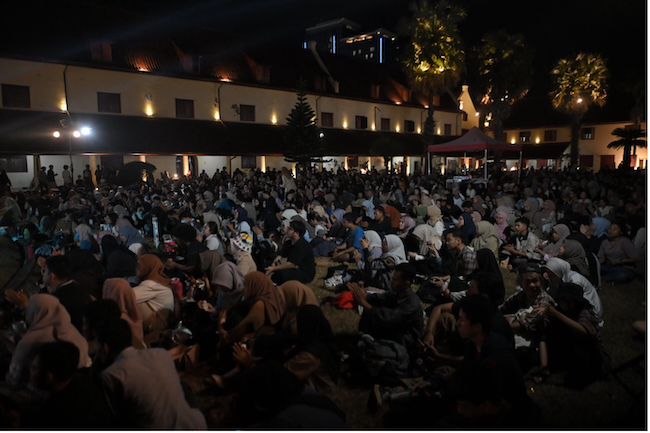
Observers from afar may talk of a wave of visibility for art from Eastern Indonesia that may be encountered sometime in the distant future. What became clear to me at MIWF 2024 is that this ‘wave’ for the arts – plural – is already here. It is being shaped by a variety of leading cross-disciplinary storytellers locally and intra-nationally. It is also carried through by the work of a younger generation of creative practitioners. It is already appearing through principles of activism and access, as well as interdisciplinary thinking. Where this momentum moves next will be watched with keen interest.
At the closing evening of MIWF I was sitting on the grass ‘under the poetic stars’ when a friend gestured to the blinking, fuzzy, warm-bright lights that illuminate Fort Rotterdam by night. They asked where else in Indonesia – indeed, in the world – one could find a similar, open venue for a writer’s festival with the historical, literary, and environmental resonances that Fort Rotterdam has. Where else, indeed.
Caitlin Hughes is a PhD Candidate in Art History and Curatorship at the University of Melbourne. Her dissertation studies a history of interdisciplinary art in Indonesia after 1998 through inter-island and international contexts; encompassing Eastern Indonesia as part of this focus.



